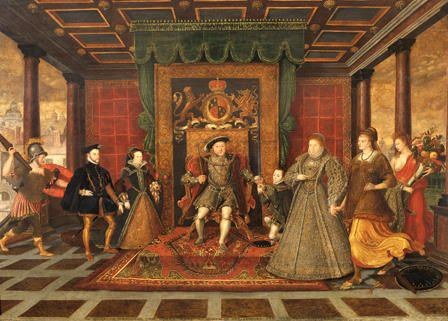13. An Allegory of the Tudor Succession
Tudor & Stewart World in 100 Objects

In December of 1570, Francis Walsingham was appointed as English ambassador to Paris. This was his first public appointment, and he probably owed it to the recommendation of Elizabeth I’s Secretary, Sir William Cecil. His appointment is likely to have pleased the earls of Leicester and Bedford, both Privy Councillors, who were his friend and patron respectively. Walsingham, like all three of these men, was a convinced Protestant.
The mission to France was not easy: Walsingham and his colleague, Sir Thomas Smith, had to broker a treaty of mutual defence with a French king whose sister-in-law, Mary, Queen of Scots, was Elizabeth’s prisoner, and who, although he may have had some sympathy with individual French Protestants (Huguenots), was obliged to maintain Catholicism as the state religion. In the background, there was a parallel negotiation, being conducted by Lord Buckhurst, for Elizabeth to marry King Charles’ brother, the Duke of Anjou.
The Treaty of Blois was finally agreed in April 1572. The parties to the treaty agreed not to aid each other’s enemies, and the French agreed that they would not intervene in Scotland to restore Queen Mary. Walsingham travelled with the Duke of Anjou to the oath-taking ceremony at Saint-German.
To mark the occasion, Elizabeth apparently commissioned a painting, now known as ‘The family of Henry VIII: an Allegory of the Tudor Succession’ which she then presented to Walsingham. This seems surprising – Elizabeth was not over-generous, and Walsingham was by no means a favourite of hers, certainly at this time. However, no other provenance has been suggested by any of Walsingham’s biographers.
The painting is about 131 x 184 cm (c. 52 x 72 inches). It was painted with oil on panel, and is probably the work of Lucas de Heere (1534 – 1584). This attribution was made by Sir Roy Strong, but has been challenged by Karen Hearn.
De Heere, son of a painter and an illustrator, built a successful career in his native Ghent – even recording the chapter of the Order of the Golden Fleece, held in Ghent in 1559 by Philip II of Spain (who as Duke of Burgundy was the sovereign of the Netherlands). Soon after, he converted to the Reformed religion, and became a partisan of Louis of Nassau, and later William of Orange, who led the revolt of the Netherlands against Philip’s overlordship.
Exiled to England with his wife in 1568, De Heere joined the ‘Stranger Church’ as the church at Austin Friars, London used by Dutch and French Huguenots was called. He remained in England until at least 1577, but the Pacification of Ghent, which had allowed his return, did not last, and he was again exiled, probably to Paris.
During his time in England he painted numerous pictures, particularly portraits.
The Allegory of the Tudor succession echoes the Hampton Court painting of the Tudor succession which shows Henry VIII in the centre, with Jane Seymour to his left, and their son and heir, Edward, in front of his father. To Henry’s far right is his elder daughter, Mary, named to succeed in the event of Edward’s demise without children, and to the king’s far left is Elizabeth, appointed to follow any heirs of Mary’s.
In the Allegory, Henry is again centre-stage (although tactfully unencumbered with any of his wives). He is handing the sword of justice to Edward VI, who kneels to accept it. To his right, Mary I stands with her husband Philip II of Spain. They are being followed by the figure of War, signifying the war with France that Mary’s marriage led to, resulting in the depressing loss of Calais, England’s last continental territory.
In contrast, Elizabeth is in the foreground, hand-in-hand with a representation of Peace and followed by Plenty. Both Peace and Plenty are depicted as feminine figures, whilst War is masculine.
At the bottom is inscribed (in capital letters): ‘The Quene to Walsingham this tablet sente marke of her peoples and her own content.’
Around the frame is written: ‘A face of muche nobillotye loe in a little roome fowr states with theyr conditions heare shadowed in a showe. A father more then valiant, a rare and virtuous soon. A zealous daughter in her kind what els the world dothe knowe and last of all a Vyrgin Queen to Englands joy we see successfully to hold the right and vertues of the three.’
The painting was part of the collection of Horace Walpole at Strawberry Hill. It was purchased by J C Dent in 1842, and was eventually gifted to the nation in lieu of inheritance tax. It is in the collection of the National Museum of Wales.
